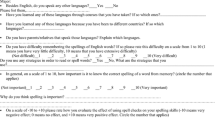Abstract
The current experiment examined the proposal thatvisible speech can help with a difficult signal suchas listening to a foreign language. This work extendsearlier work by examining whether presenting the faceof the speaker improves the accuracy of repetitions ofshort phrases of a language participants had not heardbefore (Korean) as well as examining whether thismanipulation facilitates performance on a subsequentold/new recognition task. The results showed that bothrepetition accuracy and the subsequent memory offoreign language phrases were improved by showing thespeaker's face. The implication of this finding isthat foreign language learning will benefit by usinga presentation method that includes the visible speechof the speaker. Ways that this might be reasonablyachieved using a computer interface are discussed.
Similar content being viewed by others
References
Balota, D. A. & Chumbley, J. (1985). The Locus of the Word Frequency Effect in the Pronunciation “Task” Lexical Access and/or Production? Journal of Memory and Language 24: 89-106.
Bishop, D. V. M. & Robson, J. (1989). Accurate Nonword Spelling Despite Congenital Inability to Speak: Phoneme Grapheme Conversion Does Not Require Subvocal Articulation. British Journal of Psychology 80: 1-13.
Bishop, D. V. M., Brown, B. B. & Robson, J. (1990). The Relationship Between Phoneme Discrimination, Speech Production, and Language Comprehension in Cerebral-Palsied Individuals. Journal of Speech and Hearing Research 33: 210-219.
Cairns, P., Shillcock, R., Chater, N. & Levy, J. P. (1995). Bottom-Up Connectionist Modelling of Speech. In Levy, J. P., Bairaktaris, D., Bullinaria, J. A. & Cairns, P. (eds.) Connectionist Models of Memory and Language, Chapter 15. London: UCL Press.
Catford, J. C. & Pisoni, D. B. (1970). Auditory vs. Articulatory Training in Exotic Sounds. Modern Language Journal 54: 477-481.
Cohen, M. M. & Massaro, D. W. (1994). Development and Experimentation with Synthetic Visible Speech. Behavioral Research Methods and Instrumentation 26: 260-265.
Cohen, M. M., Beskow, J. & Massaro, D. W. (1998). Recent Developments in Facial Animation: An Inside View. In Burnham, Robert-Ribes, J. & Vaitikiotis-Bateson, E. (eds.) Proceedings of ASVP'98: International Conference on Auditory Visual Speech Processing, 201-206.
Davis, C., Castles, A. & Iakovidis, E. (1998). Masked Homophone and Pseudohomophone Priming in Children and Adults. Language and Cognitive Processes 13: 625-651.
Dodd, B. (1977). The Role of Vision in the Perception of Speech. Perception 6: 31-40.
Gathercole, S. & Baddeley, A. D. (1989). Evaluation of the Role of Phonological STM in the Development of Vocabulary in Children: A Longitudinal Study. Journal of Memory and Language 28: 200-213.
Goldinger, S. D. (1998). Echoes of Echoes? An Episodic Theory of Lexical Access. Psychological Review 105: 251-279
Guiard-Marigny, T., Ostry, D. J. & Benoît, C. (1995). Speech Intelligibility of Synthetic Lips and Jaw. Proceedings of the 13th International Congress of Phonetic Sciences (3), 222-225. Sweden: Stockholm.
Jenkins, W.M., Merzenich, M. M., Jacobson, T., Miller, S. L., Schreiner C. & Tallal. P (1995). Training Exercises Improve Temporal Processing Abilities in Language-Based Learning Disabled Children (LLDS): Use-Dependent Reorganization. Soc. Neuro. 21: 421.
Munhall, K. G. & Vatikiotis-Bateson, E. (1998). The Moving Face During Speech Communication. In Cambell, R., Dodd, B. and Burnham, D. (eds.) Hearing by Eye, Part 2: The Psychology of Speechreading and Audiovisual Speech. London: Taylor and Francis, Psychology Press.
Pollatsek, A. & Well, A. D. (1995). On the Use of Counterbalanced Designs in Cognitive Research: A Suggestion for a Better and More Powerful Analysis. Journal of Experimental Psychology: Learning, Memory, and Cognition 21: 785-794.
Portnoff, R. (1980). Time-Frequency Representation of Digital Signals and Systems Based on Short-Time Fourier Analysis. IEEE Trans. ASSP ASSP-28: 55-69.
Reisberg, D, McLean, J. & Goldfield, A. (1987). Easy to Hear to Understand: A Lip-Reading Advantage with Intact Auditory Stimuli. In Dodd, B. and Cambell, R. (eds.) Hearing by Eye: The Psychology of Lip-Reading, 97-113. London: Lawrence Erlbaum.
Sanders, D. & Goodrich, S. (1971). The Relative Contribution of Visual and Auditory Attention. Journal of Speech and Hearing Research 14: 154-159.
Silsbee, P. L. & Bovik, A. C. (1996). Computer Lipreading for Improved Accuracy in Automatic Speech Recognition. IEEE, Transactions on Speech and Audio Processing 4: 337-351.
Tallal, P., Miller, S. L., Bedi, G., Byma, G., Jenkins, X., Wang, S. S., Nagarajan & Merzenich, M. M. (1995). Training With Temporally Modified Speech Results in Dramatic Improvements in Speech Perception and Language Comprehension, CA. Soc. Neuropsychology 21: 421.
Thompson, L. A. & Ogden, W. C. (1995). Visible Speech Improves Human Language Understanding: Implications for Speech Processing Systems. Artificial Intelligence Review 9: 347-358.
Werker, J. F. & Logan, J. (1985). Phonemic and Phonetic Factors in Adult Cross-Language Speech Perception. Perception and Psychophysics 37: 35-44.
Author information
Authors and Affiliations
Rights and permissions
About this article
Cite this article
Davis, C., Kim, J. Repeating and Remembering Foreign Language Words: Implications for Language Teaching Systems. Artificial Intelligence Review 16, 37–47 (2001). https://doi.org/10.1023/A:1011086120667
Issue Date:
DOI: https://doi.org/10.1023/A:1011086120667




